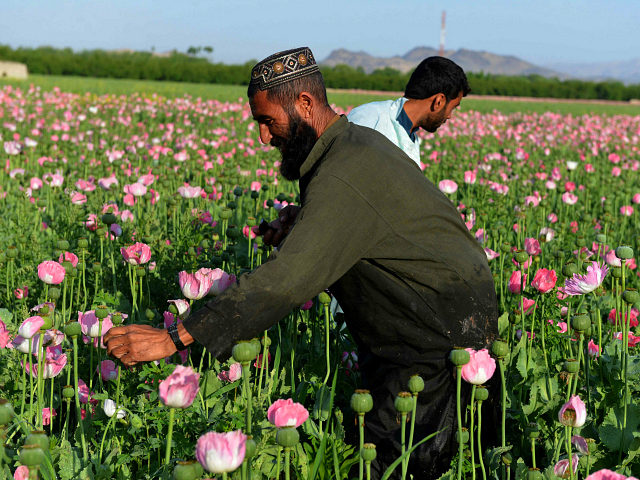Efforts to eradicate opium in Afghanistan dropped by nearly 90 percent last year as the cultivation of the illicit drug, which as heroin provides an estimated 60 percent of Taliban funding, reached unprecedented levels.
The Special Inspector General for Afghanistan Reconstruction (SIGAR), a U.S. watchdog agency, published a report revealing the alarming trend this week. Meanwhile, a heroin crisis deemed the worst drug addiction epidemic in U.S. history has gripped the United States.
Although the DEA estimates that only about one percent of the heroin in the United States originates from Afghanistan, the world’s top producer of opium, some analysts believe it is impossible that only such small amount reaches American soil.
The DEA has acknowledged that the majority of heroin in neighboring Canada is produced in Afghanistan.
As heroin overdose deaths in the United States have reached historic levels, surpassing gun homicides, the U.S. is spending millions to treat opium-related addiction in Afghanistan.
“The United States has committed more than $8.5 billion to counternarcotics efforts in Afghanistan, the country still leads the world in opium production, and Afghan farmers are growing more opium than ever,” notes SIGAR in its latest quarterly report to Congress, the last to cover the Barack Obama administration.
Citing the United Nations, SIGAR points out that eradication efforts in 2016 “were the lowest this decade at 355 hectares—a 91% decrease from 2015,” while opium production skyrocketed 43 percent over 2015’s levels, to an estimated 4,800 tons.
Afghan territory under opium cultivation also increased this year by 10 percent, to 201,000 hectares (about 776 square miles), compared to last year’s total.
The area under opium cultivation is equivalent to more than 11 times the size of Washington, D.C.
SIGAR notes, “The opium produced is exported as either raw opium or heroin/morphine, consumed domestically in different forms, seized, stored, or lost.”
American Gen. John Nicholson, the top commander of U.S. and NATO forces, estimated at the end of last year that the Taliban generates more than half of its funding from the lucrative opium business.
“They [the Taliban] receive much of their funding from the narcotics trafficking that occurs out of Helmand,” the commander told reporters in December. “As you know, Helmand produces a significant amount of the opium globally that turns into heroin and this provides about 60 percent of the Taliban funding, we believe.”
For years, the Pentagon has reported that revenue from opium trafficking is sustaining the insurgency in Afghanistan.
Meanwhile, the Taliban has grown stronger and is believed to have captured more territory under former President Barack Obama than at any time since it was removed from power by the U.S. military in 2001.
“While opium is not counted in official GDP [Gross Domestic Product] estimates, its earnings boost domestic demand and are a significant source of foreign exchange,” reveals SIGAR. “The 2016 farm-gate value of opium production was almost $900 million, roughly 5% of GDP, and a 57% increase over 2015.”
John Sopko, chief of SIGAR, has acknowledged that the cultivation and trafficking of opium in Afghanistan puts the entire estimated $117 billion U.S. taxpayer investment in the reconstruction of Afghanistan at risk.
In February 2015, Sopko told lawmakers:
The narcotics trade, which not only supports the insurgency but also feeds organized crime and corruption, puts the gains the U.S. agencies and their international partners have achieved over the past 13 years in women’s issues, health, education, rule of law, and governance in jeopardy.
Helmand, a Taliban stronghold in southern Afghanistan that borders Pakistan, remains the country’s main opium poppy-cultivating province.
More than half of the province is currently under the control or influence of terrorists.
The DEA claims most of the heroin in the United States is produced in Mexico.
However, an article published by the Alliance for Human Research Protection (AHRP), a patient advocacy group, criticizes the Obama administration and the mainstream media for misleading the American public about the influx of heroin from Afghanistan.
The article cites William Edstrom, identified as a scientist and author of articles in scientific journals, including the Journal of Biological Chemistry, as writing:
Heroin from Mexico cannot supply even 10% of US heroin demand. Yet the DEA claims most heroin in the US is from Mexico.
Most heroin in the US is coming from US-occupied Afghanistan. We’re getting hit with the largest ever illicit drug epidemic in American history and the DEA is asleep at the wheel.
Using U.N. data, Breitbart News has determined that opium production has dramatically increased since the U.S.-led invasion of Afghanistan in 2001.
SIGAR notes that the U.N. may have underestimated its most recent estimate for historic opium production in 2016 given the international body’s inability to reach various top-producing regions for security reasons.
The U.N. “delivers estimates for only a single harvest, yet credible reports indicate that Afghan farmers have been reaping multiple harvests in recent years,” adds the inspector general.

COMMENTS
Please let us know if you're having issues with commenting.